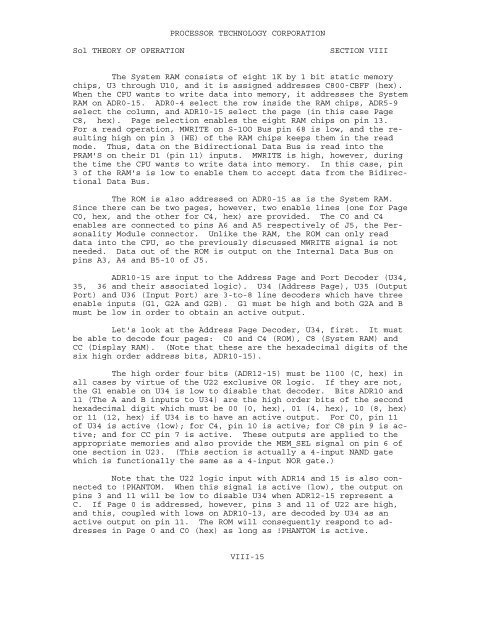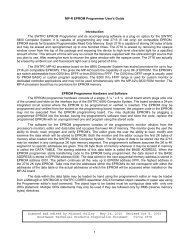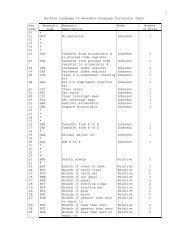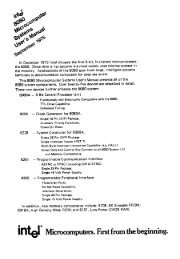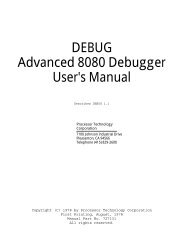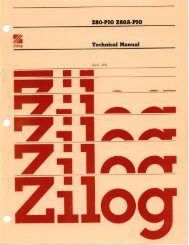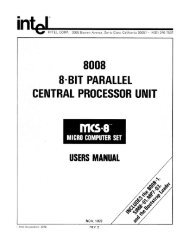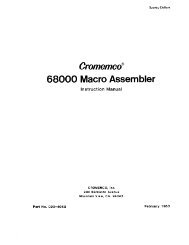The System Manual of SOL-20 - History of Computers
The System Manual of SOL-20 - History of Computers
The System Manual of SOL-20 - History of Computers
You also want an ePaper? Increase the reach of your titles
YUMPU automatically turns print PDFs into web optimized ePapers that Google loves.
PROCESSOR TECHNOLOGY CORPORATION<br />
Sol THEORY OF OPERATION<br />
SECTION VIII<br />
<strong>The</strong> <strong>System</strong> RAM consists <strong>of</strong> eight 1K by 1 bit static memory<br />
chips, U3 through U10, and it is assigned addresses C800-CBFF (hex).<br />
When the CPU wants to write data into memory, it addresses the <strong>System</strong><br />
RAM on ADR0-15. ADR0-4 select the row inside the RAM chips, ADR5-9<br />
select the column, and ADR10-15 select the page (in this case Page<br />
C8, hex). Page selection enables the eight RAM chips on pin 13.<br />
For a read operation, MWRITE on S-1OO Bus pin 68 is low, and the resulting<br />
high on pin 3 (WE) <strong>of</strong> the RAM chips keeps them in the read<br />
mode. Thus, data on the Bidirectional Data Bus is read into the<br />
PRAM'S on their D1 (pin 11) inputs. MWRITE is high, however, during<br />
the time the CPU wants to write data into memory. In this case, pin<br />
3 <strong>of</strong> the RAM's is low to enable them to accept data from the Bidirectional<br />
Data Bus.<br />
<strong>The</strong> ROM is also addressed on ADR0-15 as is the <strong>System</strong> RAM.<br />
Since there can be two pages, however, two enable lines (one for Page<br />
C0, hex, and the other for C4, hex) are provided. <strong>The</strong> C0 and C4<br />
enables are connected to pins A6 and A5 respectively <strong>of</strong> J5, the Personality<br />
Module connector. Unlike the RAM, the ROM can only read<br />
data into the CPU, so the previously discussed MWRITE signal is not<br />
needed. Data out <strong>of</strong> the ROM is output on the Internal Data Bus on<br />
pins A3, A4 and B5-10 <strong>of</strong> J5.<br />
ADR10-15 are input to the Address Page and Port Decoder (U34,<br />
35, 36 and their associated logic). U34 (Address Page), U35 (Output<br />
Port) and U36 (Input Port) are 3-to-8 line decoders which have three<br />
enable inputs (G1, G2A and G2B). G1 must be high and both G2A and B<br />
must be low in order to obtain an active output.<br />
Let's look at the Address Page Decoder, U34, first. It must<br />
be able to decode four pages: C0 and C4 (ROM), C8 (<strong>System</strong> RAM) and<br />
CC (Display RAM). (Note that these are the hexadecimal digits <strong>of</strong> the<br />
six high order address bits, ADR10-15).<br />
<strong>The</strong> high order four bits (ADR12-15) must be 1100 (C, hex) in<br />
all cases by virtue <strong>of</strong> the U22 exclusive OR logic. If they are not,<br />
the G1 enable on U34 is low to disable that decoder. Bits ADR10 and<br />
11 (<strong>The</strong> A and B inputs to U34) are the high order bits <strong>of</strong> the second<br />
hexadecimal digit which must be 00 (0, hex), 01 (4, hex), 10 (8, hex)<br />
or 11 (12, hex) if U34 is to have an active output. For C0, pin 11<br />
<strong>of</strong> U34 is active (low); for C4, pin 10 is active; for C8 pin 9 is active;<br />
and for CC pin 7 is active. <strong>The</strong>se outputs are applied to the<br />
appropriate memories and also provide the MEM_SEL signal on pin 6 <strong>of</strong><br />
one section in U23. (This section is actually a 4-input NAND gate<br />
which is functionally the same as a 4-input NOR gate.)<br />
Note that the U22 logic input with ADR14 and 15 is also connected<br />
to !PHANTOM. When this signal is active (low), the output on<br />
pins 3 and 11 will be low to disable U34 when ADR12-15 represent a<br />
C. If Page 0 is addressed, however, pins 3 and 11 <strong>of</strong> U22 are high,<br />
and this, coupled with lows on ADR10-13, are decoded by U34 as an<br />
active output on pin 11. <strong>The</strong> ROM will consequently respond to addresses<br />
in Page 0 and C0 (hex) as long as !PHANTOM is active.<br />
VIII-15


